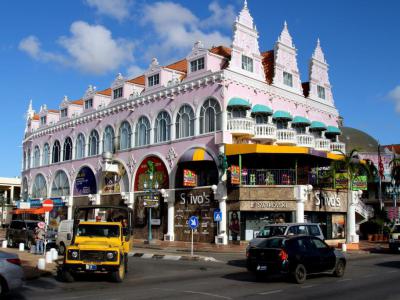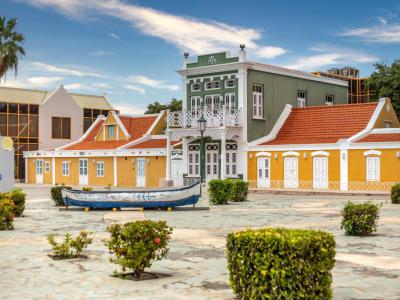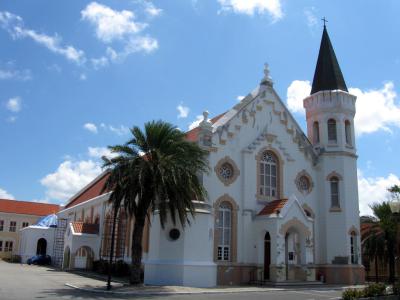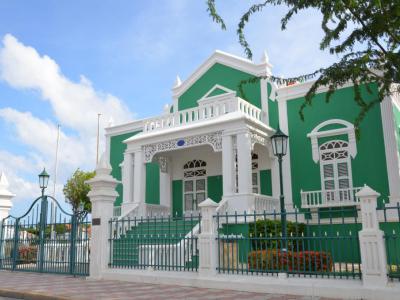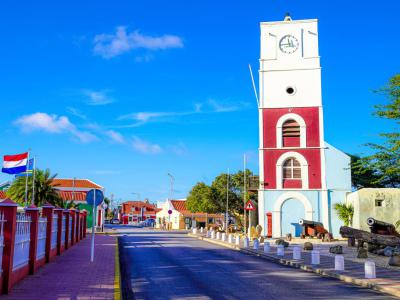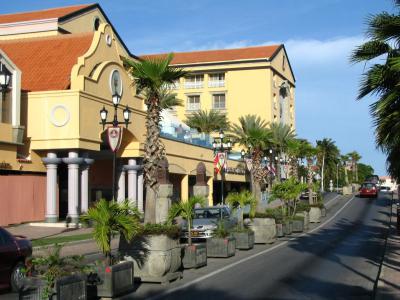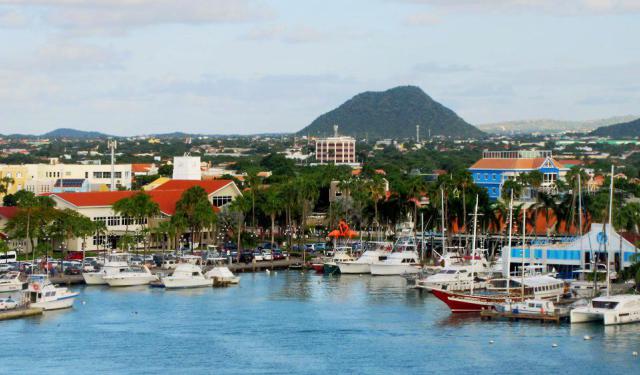
Oranjestad Introduction Walking Tour (Self Guided), Oranjestad
Perched along the Dutch Caribbean Sea shore lies the picturesque capital of Aruba, Oranjestad. The locals still habitually refer to it as "Playa".
European settlers arrived on the island around 1754, establishing plantations along the coast. Urban development began around 1795-1796 as trade restrictions eased. Jewish settlers engaged in discreet smuggling from around 1796 chose Aruba for its favorable location, namely the "Bay of Horses" (Paardenbaai) – currently home to the Port of Oranjestad, the main passenger seaport in Aruba.
Fort Zoutman erected in 1798, marked a significant period when traders shifted their attention to Aruba. It was due to illegal trade from Aruba that the village of Playa grew. In 1824, it was renamed Oranjestad (literally "Orange City") after William I of the Netherlands (and of Orange-Nassau). The discovery of gold in the same year prompted a renewed interest in Aruban colonization.
By the mid-19th century, Oranjestad experienced significant population growth, particularly with the establishment of oil refineries. The oil industry, established in the early 20th century, further fueled Oranjestad's growth, attracting traders, craftsmen, and shopkeepers. The economic boom led to the emergence of luxurious houses, marking a period of prosperity for the city.
Today's Oranjestad is a bustling hub of activity. One of its highlights is the Aruba Cruise Port, where visitors from around the world arrive to experience the island's warmth and hospitality. Nearby, the outdoor mall at Royal Plaza beckons shoppers with its array of duty-free boutiques, perfect for indulging in some retail therapy.
For those eager to delve into Aruba's history, the National Archaeological Museum is a must.
Oranjestad is also home to several iconic landmarks, such as the San Francisco Church, a striking example of Dutch colonial architecture, and the elegant lime-colored City Hall.
History buffs will delight in exploring Fort Zoutman Historical Museum of Aruba, the island's oldest structure. The city's man-made expansion into the sea features notable areas like the Renaissance Marketplace and Queen Wilhelmina Park.
Adorned with vibrant pastel-colored Dutch colonial buildings and swaying palm trees, the alluring city of Oranjestad offers a delightful blend of culture and coastal beauty, making it a destination like no other in the world. With the help of our self-guided tour, you can embark on your own adventure and discover the magic of this Caribbean gem today!
European settlers arrived on the island around 1754, establishing plantations along the coast. Urban development began around 1795-1796 as trade restrictions eased. Jewish settlers engaged in discreet smuggling from around 1796 chose Aruba for its favorable location, namely the "Bay of Horses" (Paardenbaai) – currently home to the Port of Oranjestad, the main passenger seaport in Aruba.
Fort Zoutman erected in 1798, marked a significant period when traders shifted their attention to Aruba. It was due to illegal trade from Aruba that the village of Playa grew. In 1824, it was renamed Oranjestad (literally "Orange City") after William I of the Netherlands (and of Orange-Nassau). The discovery of gold in the same year prompted a renewed interest in Aruban colonization.
By the mid-19th century, Oranjestad experienced significant population growth, particularly with the establishment of oil refineries. The oil industry, established in the early 20th century, further fueled Oranjestad's growth, attracting traders, craftsmen, and shopkeepers. The economic boom led to the emergence of luxurious houses, marking a period of prosperity for the city.
Today's Oranjestad is a bustling hub of activity. One of its highlights is the Aruba Cruise Port, where visitors from around the world arrive to experience the island's warmth and hospitality. Nearby, the outdoor mall at Royal Plaza beckons shoppers with its array of duty-free boutiques, perfect for indulging in some retail therapy.
For those eager to delve into Aruba's history, the National Archaeological Museum is a must.
Oranjestad is also home to several iconic landmarks, such as the San Francisco Church, a striking example of Dutch colonial architecture, and the elegant lime-colored City Hall.
History buffs will delight in exploring Fort Zoutman Historical Museum of Aruba, the island's oldest structure. The city's man-made expansion into the sea features notable areas like the Renaissance Marketplace and Queen Wilhelmina Park.
Adorned with vibrant pastel-colored Dutch colonial buildings and swaying palm trees, the alluring city of Oranjestad offers a delightful blend of culture and coastal beauty, making it a destination like no other in the world. With the help of our self-guided tour, you can embark on your own adventure and discover the magic of this Caribbean gem today!
How it works: Download the app "GPSmyCity: Walks in 1K+ Cities" from Apple App Store or Google Play Store to your mobile phone or tablet. The app turns your mobile device into a personal tour guide and its built-in GPS navigation functions guide you from one tour stop to next. The app works offline, so no data plan is needed when traveling abroad.
Oranjestad Introduction Walking Tour Map
Guide Name: Oranjestad Introduction Walking Tour
Guide Location: Aruba » Oranjestad (See other walking tours in Oranjestad)
Guide Type: Self-guided Walking Tour (Sightseeing)
# of Attractions: 9
Tour Duration: 2 Hour(s)
Travel Distance: 2.5 Km or 1.6 Miles
Author: nataly
Sight(s) Featured in This Guide:
Guide Location: Aruba » Oranjestad (See other walking tours in Oranjestad)
Guide Type: Self-guided Walking Tour (Sightseeing)
# of Attractions: 9
Tour Duration: 2 Hour(s)
Travel Distance: 2.5 Km or 1.6 Miles
Author: nataly
Sight(s) Featured in This Guide:
- Aruba Cruise Port
- Royal Plaza Mall
- National Archaeological Museum Aruba
- Saint Francis of Assisi Church
- City Hall
- Fort Zoutman Historical Museum of Aruba
- Wilhelmina Park
- Renaissance Marketplace
- Renaissance Mall
1) Aruba Cruise Port
The Aruba Cruise Port is a bustling and vibrant gateway for cruise ship passengers visiting this popular Caribbean destination. Managed by the Aruba Port Authority, the port terminal is a large and well-equipped building designed to handle the arrival and departure of cruise ships.
Offering a warm and welcoming atmosphere, the port provides a range of facilities and services to ensure a pleasant experience for travelers exploring the diverse attractions of Aruba. The cruise terminal hosts a variety of shops, including a local straw market, where passengers can explore and purchase a range of items. Local vendors offer unique products, providing an opportunity for visitors to buy souvenirs and experience the vibrant local culture.
The Aruba Cruise Port is situated along the picturesque waterfront of Oranjestad, offering passengers stunning views of the Caribbean Sea and the colorful architecture of the city. The port is also strategically located in close proximity to Oranjestad's attractions, making it convenient for cruise visitors to explore the city's landmarks, shopping districts, and cultural sites on foot.
Offering a warm and welcoming atmosphere, the port provides a range of facilities and services to ensure a pleasant experience for travelers exploring the diverse attractions of Aruba. The cruise terminal hosts a variety of shops, including a local straw market, where passengers can explore and purchase a range of items. Local vendors offer unique products, providing an opportunity for visitors to buy souvenirs and experience the vibrant local culture.
The Aruba Cruise Port is situated along the picturesque waterfront of Oranjestad, offering passengers stunning views of the Caribbean Sea and the colorful architecture of the city. The port is also strategically located in close proximity to Oranjestad's attractions, making it convenient for cruise visitors to explore the city's landmarks, shopping districts, and cultural sites on foot.
2) Royal Plaza Mall
Royal Plaza Mall stands as a vibrant and iconic shopping destination in downtown Oranjestad. With its distinctive architecture resembling a giant pink decorated cake, this mid-town landmark offers a unique and delightful shopping experience for visitors. Strategically positioned across from the cruise ship terminal, Royal Plaza Mall is easily accessible to cruise passengers and visitors exploring downtown Oranjestad. Surrounded by the bus station, flea markets, museums, and the main street, the mall serves as a central hub for shopping and entertainment.
Inside the mall, visitors encounter a broad variety of specialty venues and shops, catering to diverse tastes and preferences.
International luxury brand stores such as Tommy Hilfiger and Nautica coexist with exclusive jewelers like Little Switzerland and the island's official Rolex retailer, Gandelman Jewelers.
Royal Plaza Mall features a mix of authentic Aruban souvenir shops, allowing visitors to take home unique mementos from their Caribbean experience.
Aruba's favorite surf shop, Bula, adds a touch of local flavor, offering a range of surf-related products.
During the day, Royal Plaza Mall offers a selection of bars and eateries serving light fare for lunch and dinner.
As night falls, Mojito's Cantina & Grill transforms into a lively salsa dance club, providing visitors with an opportunity to enjoy Aruba's nightlife.
The mall's second floor provides a picturesque view overlooking the Caribbean Sea, enhancing the shopping experience with a scenic backdrop.
Inside the mall, visitors encounter a broad variety of specialty venues and shops, catering to diverse tastes and preferences.
International luxury brand stores such as Tommy Hilfiger and Nautica coexist with exclusive jewelers like Little Switzerland and the island's official Rolex retailer, Gandelman Jewelers.
Royal Plaza Mall features a mix of authentic Aruban souvenir shops, allowing visitors to take home unique mementos from their Caribbean experience.
Aruba's favorite surf shop, Bula, adds a touch of local flavor, offering a range of surf-related products.
During the day, Royal Plaza Mall offers a selection of bars and eateries serving light fare for lunch and dinner.
As night falls, Mojito's Cantina & Grill transforms into a lively salsa dance club, providing visitors with an opportunity to enjoy Aruba's nightlife.
The mall's second floor provides a picturesque view overlooking the Caribbean Sea, enhancing the shopping experience with a scenic backdrop.
3) National Archaeological Museum Aruba (must see)
The National Archaeological Museum Aruba (NAMA) stands as a beacon celebrating over 5000 years of Amerindian culture on the island. In a landmark moment on July 26, 2009, the museum found its home in the beautifully restored former dwellings of the Ecury family, one of Aruba's most significant historic landmarks. The inauguration was graced by the presence of Her Royal Highness Princess Margriet of the Netherlands and Professor Pieter van Vollenhoven, accompanied by an open-air show featuring artists from across the Kingdom.
NAMA boasts a collection of over 10,000 Amerindian artifacts spanning the Pre-Ceramic, Ceramic, and Historic Cultural Periods. The diverse array of artifacts includes pottery, shell, stone, bone, and glass, offering insights into Amerindian daily life, spirituality, and their extensive communication network connecting Aruba to Europe, Mexico, and central South America.
The archaeological staff at NAMA is actively involved in researching the collections, leading excavations, and preserving key heritage sites, including the remarkable cave paintings located in Arikok National Park.
The museum's 580 m2 permanent exhibition provides an exciting, interactive, and educational experience for residents and tourists alike.
Thematic experiences exploring Home Life, Artistic and Sacred Expression, Origins and Exchanges, and the Past in the Present bring Aruba's rich cultural heritage to life. Visitors are treated to reconstructed environments, multimedia presentations, and hands-on activities that showcase Aruba's archaeological treasures. Themed exhibits, such as 'Rancho,' pay homage to the museum's neighborhood, offering diverse perspectives on Aruba's heritage.
NAMA boasts a collection of over 10,000 Amerindian artifacts spanning the Pre-Ceramic, Ceramic, and Historic Cultural Periods. The diverse array of artifacts includes pottery, shell, stone, bone, and glass, offering insights into Amerindian daily life, spirituality, and their extensive communication network connecting Aruba to Europe, Mexico, and central South America.
The archaeological staff at NAMA is actively involved in researching the collections, leading excavations, and preserving key heritage sites, including the remarkable cave paintings located in Arikok National Park.
The museum's 580 m2 permanent exhibition provides an exciting, interactive, and educational experience for residents and tourists alike.
Thematic experiences exploring Home Life, Artistic and Sacred Expression, Origins and Exchanges, and the Past in the Present bring Aruba's rich cultural heritage to life. Visitors are treated to reconstructed environments, multimedia presentations, and hands-on activities that showcase Aruba's archaeological treasures. Themed exhibits, such as 'Rancho,' pay homage to the museum's neighborhood, offering diverse perspectives on Aruba's heritage.
4) Saint Francis of Assisi Church (must see)
The Pro Cathedral of Saint Francis of Assisi stands as the main Roman Catholic church on the island. Built in 1919, the church is a cornerstone of Oranjestad's cultural and architectural heritage. The church's tower, for a considerable period, served as a prominent reference point for sailors, being the highest structure in the area.
The current structure is the fifth Saint Francis Church built on this location, reflecting a journey of resilience and continuity. The first Saint Francis Church, constructed between 1809 and 1813, had walls of plaited branches and a roof of cornstalks, collapsing during a rainstorm in 1828. The second Saint Francis Church, consecrated in 1828, faced a similar fate, collapsing before its official consecration. The surviving parts were swiftly rebuilt.
The third Saint Francis Church, with the foundation stone laid on April 22, 1864, collapsed before consecration, leading to a partial reconstruction of the surviving elements. The fourth SaintFrancis Church, consecrated on May 1st, 1871, shared design similarities with Saint Anne's Church in Noord, both being creations of the priest Stephanus van de Pavert.
The Saint Francis Church is part of the Franciscan complex, which includes an accompanying rectory.
The current structure is the fifth Saint Francis Church built on this location, reflecting a journey of resilience and continuity. The first Saint Francis Church, constructed between 1809 and 1813, had walls of plaited branches and a roof of cornstalks, collapsing during a rainstorm in 1828. The second Saint Francis Church, consecrated in 1828, faced a similar fate, collapsing before its official consecration. The surviving parts were swiftly rebuilt.
The third Saint Francis Church, with the foundation stone laid on April 22, 1864, collapsed before consecration, leading to a partial reconstruction of the surviving elements. The fourth SaintFrancis Church, consecrated on May 1st, 1871, shared design similarities with Saint Anne's Church in Noord, both being creations of the priest Stephanus van de Pavert.
The Saint Francis Church is part of the Franciscan complex, which includes an accompanying rectory.
5) City Hall
City Hall, also known as the Eloy Arends House, stands as a historical and functional landmark in Oranjestad. Constructed in 1922, the Eloy Arends House was initially designed as a residence for Dr. Jacobo Eloy Maria Arends and his fiancée, Maria Monica Laclé. The architect, Chibi Wever, infused South American Neo-Baroque influences into the design, creating a structure that harmonized with its surroundings.
The house incorporates sliding doors, allowing for adaptable use of interior spaces, showcasing a thoughtful and functional design. Over the years, the Eloy Arends House underwent various transformations, serving as a doctor's office, dentist's office, restaurant, and, controversially, as the headquarters of the People's Electoral Movement (MEP) in 1985.
In 1993, a fire caused significant damage to the building, leading to a period of neglect and homelessness. In 1997, the house underwent a meticulous restoration, transforming it into the official location for civil registration services.
The City Hall has become a popular destination for tourists to tie the knot, adding a romantic touch to its role as a hub for civil registrations.
Its historical charm and well-maintained aesthetics make it an attractive venue for couples seeking a unique and memorable wedding experience.
The house incorporates sliding doors, allowing for adaptable use of interior spaces, showcasing a thoughtful and functional design. Over the years, the Eloy Arends House underwent various transformations, serving as a doctor's office, dentist's office, restaurant, and, controversially, as the headquarters of the People's Electoral Movement (MEP) in 1985.
In 1993, a fire caused significant damage to the building, leading to a period of neglect and homelessness. In 1997, the house underwent a meticulous restoration, transforming it into the official location for civil registration services.
The City Hall has become a popular destination for tourists to tie the knot, adding a romantic touch to its role as a hub for civil registrations.
Its historical charm and well-maintained aesthetics make it an attractive venue for couples seeking a unique and memorable wedding experience.
6) Fort Zoutman Historical Museum of Aruba
The Fort Zoutman Historical Museum stands as a testament to the island's enduring history. Constructed in 1796 for coastal defense, it is the oldest remaining building in Oranjestad.
Fort Zoutman was erected over a two-year period, with the primary purpose of safeguarding the coastline of Aruba. Named after Dutch Rear Admiral Johan Arnold Zoutman, the fort played a pivotal role in protecting the island from potential threats. Adjacent to the fort, the Willem III Tower, built in 1868, served a dual purpose as a lighthouse and public clock tower. This iconic structure, marking the original entrance to the fort, illuminated the coastline for 95 years before its light was extinguished in 1963.
As you step inside Fort Zoutman, you are greeted by an immersive experience that transports you back in time. The historical museum houses a collection of documents and artifacts that chronicle Aruba's past, providing a unique insight into its cultural and developmental evolution.
Within the courtyard, a meticulously crafted replica kitchen provides a glimpse into the culinary practices of Aruba's yesteryears.
This interactive exhibit showcases the methods of cooking that were prevalent in historical Aruban households.
Every Tuesday night, Fort Zoutman comes alive with the Bon Bini Festival from 6:30 – 8:30 pm, offering visitors an engaging celebration of Aruba's culture and history. Guests have the opportunity to immerse themselves in the vibrant traditions, music, and dance that define the island.
Fort Zoutman was erected over a two-year period, with the primary purpose of safeguarding the coastline of Aruba. Named after Dutch Rear Admiral Johan Arnold Zoutman, the fort played a pivotal role in protecting the island from potential threats. Adjacent to the fort, the Willem III Tower, built in 1868, served a dual purpose as a lighthouse and public clock tower. This iconic structure, marking the original entrance to the fort, illuminated the coastline for 95 years before its light was extinguished in 1963.
As you step inside Fort Zoutman, you are greeted by an immersive experience that transports you back in time. The historical museum houses a collection of documents and artifacts that chronicle Aruba's past, providing a unique insight into its cultural and developmental evolution.
Within the courtyard, a meticulously crafted replica kitchen provides a glimpse into the culinary practices of Aruba's yesteryears.
This interactive exhibit showcases the methods of cooking that were prevalent in historical Aruban households.
Every Tuesday night, Fort Zoutman comes alive with the Bon Bini Festival from 6:30 – 8:30 pm, offering visitors an engaging celebration of Aruba's culture and history. Guests have the opportunity to immerse themselves in the vibrant traditions, music, and dance that define the island.
7) Wilhelmina Park
Nestled along the picturesque coastline of Oranjestad, Wilhelmina Park stands as a serene and inviting seaside escape. The park is adorned with statues paying homage to historical figures. A prominent feature is the statue of Queen Wilhelmina, a symbol of Aruba's connection to the Dutch monarchy. Another notable statue within the park is dedicated to Anne Frank, offering a poignant tribute to the resilience and spirit of the human experience.
Wilhelmina Park provides an idyllic setting for those seeking tranquility by the sea. Its location along the waterfront offers breathtaking views of the Caribbean Sea. Visitors can bask in the beauty of the coastline and marvel at the vibrant hues of the ocean, creating a perfect backdrop for relaxation.
Nature enthusiasts are in for a treat as the park is often frequented by wild iguanas. These fascinating creatures add a touch of the exotic to the park's natural ambiance. Observing these creatures in their natural habitat becomes a delightful and unexpected highlight for visitors.
A well-designed pedestrian pathway winds its way along the Caribbean Sea, inviting visitors to take a leisurely stroll and soak in the coastal atmosphere. The pathway extends from Queen Wilhelmina Park to Renaissance Beach and up to the boat harbor, providing an immersive experience of Aruba's coastal beauty.
Adjacent to the park, the Renaissance Marketplace offers a vibrant and inviting space for visitors to unwind. Enjoy a cup of coffee or indulge in a delicious bite to eat amidst the lively atmosphere.
Wilhelmina Park provides an idyllic setting for those seeking tranquility by the sea. Its location along the waterfront offers breathtaking views of the Caribbean Sea. Visitors can bask in the beauty of the coastline and marvel at the vibrant hues of the ocean, creating a perfect backdrop for relaxation.
Nature enthusiasts are in for a treat as the park is often frequented by wild iguanas. These fascinating creatures add a touch of the exotic to the park's natural ambiance. Observing these creatures in their natural habitat becomes a delightful and unexpected highlight for visitors.
A well-designed pedestrian pathway winds its way along the Caribbean Sea, inviting visitors to take a leisurely stroll and soak in the coastal atmosphere. The pathway extends from Queen Wilhelmina Park to Renaissance Beach and up to the boat harbor, providing an immersive experience of Aruba's coastal beauty.
Adjacent to the park, the Renaissance Marketplace offers a vibrant and inviting space for visitors to unwind. Enjoy a cup of coffee or indulge in a delicious bite to eat amidst the lively atmosphere.
8) Renaissance Marketplace
The Renaissance Marketplace stands as a vibrant outdoor destination where a diverse array of entertainment, culinary experiences, and shopping delights converge, creating an atmosphere of lively ambiance and cultural fusion.
The marketplace is a hub of entertainment, featuring daily live music events that add a melodic touch to the vibrant surroundings. Various stages and the lively atmosphere of "5 o’clock somewhere," a bar with a DJ, invite guests to linger and soak in the lively ambiance.
The Renaissance Marketplace is a haven for food enthusiasts, offering an eclectic mix of international cuisines. From BBQ and Japanese delights to avant-garde Mexican cuisine and Dutch pancakes, the marketplace caters to a diverse range of palates. Franchise favorites like Starbucks and Dunkin' Donuts are also part of the culinary lineup.
Charming boutiques within the marketplace offer a shopping spree for visitors. Explore apparel for men and women, eyewear, resort wear, jewelry, beauty products, and souvenirs.
As the night falls, the marketplace transforms into a captivating space known as "ambiente" in Aruba. Live entertainment accompanies dinners, creating a lively atmosphere. Guests can dance the night away at various events, making evenings at the Renaissance Marketplace a memorable experience.
The marketplace is a hub of entertainment, featuring daily live music events that add a melodic touch to the vibrant surroundings. Various stages and the lively atmosphere of "5 o’clock somewhere," a bar with a DJ, invite guests to linger and soak in the lively ambiance.
The Renaissance Marketplace is a haven for food enthusiasts, offering an eclectic mix of international cuisines. From BBQ and Japanese delights to avant-garde Mexican cuisine and Dutch pancakes, the marketplace caters to a diverse range of palates. Franchise favorites like Starbucks and Dunkin' Donuts are also part of the culinary lineup.
Charming boutiques within the marketplace offer a shopping spree for visitors. Explore apparel for men and women, eyewear, resort wear, jewelry, beauty products, and souvenirs.
As the night falls, the marketplace transforms into a captivating space known as "ambiente" in Aruba. Live entertainment accompanies dinners, creating a lively atmosphere. Guests can dance the night away at various events, making evenings at the Renaissance Marketplace a memorable experience.
9) Renaissance Mall
The Renaissance Mall stands as the epitome of luxury and sophistication in the Caribbean. Boasting an impressive array of high-end retailers under one roof, this fashion haven has become a must-visit destination for discerning shoppers. Here's an overview of what makes the Renaissance Mall a premier luxury shopping experience:
Renaissance Mall is renowned for its curated collection of high-end brands, offering a diverse range of products to satisfy the desires of fashion enthusiasts. Visitors can explore a selection of women’s and men’s apparel, footwear, eyewear, perfumes, cosmetics, and jewelry, all sourced from prestigious and internationally acclaimed designers.
The mall hosts an impressive lineup of A-list designer stores, making it the exclusive Caribbean destination for luxury shopping.
Among the distinguished brands featured are Louis Vuitton, Prada, Gucci, Dolce & Gabbana, Carolina Herrera, Michael Kors, Kate Spade, Chopard, David Yurman, and Cartier.
The ambiance and design of the mall contribute to a sophisticated atmosphere, aligning with the caliber of the luxury brands it houses.
Renaissance Mall is renowned for its curated collection of high-end brands, offering a diverse range of products to satisfy the desires of fashion enthusiasts. Visitors can explore a selection of women’s and men’s apparel, footwear, eyewear, perfumes, cosmetics, and jewelry, all sourced from prestigious and internationally acclaimed designers.
The mall hosts an impressive lineup of A-list designer stores, making it the exclusive Caribbean destination for luxury shopping.
Among the distinguished brands featured are Louis Vuitton, Prada, Gucci, Dolce & Gabbana, Carolina Herrera, Michael Kors, Kate Spade, Chopard, David Yurman, and Cartier.
The ambiance and design of the mall contribute to a sophisticated atmosphere, aligning with the caliber of the luxury brands it houses.
The Most Popular Cities
/ view all

